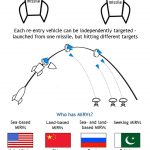Senior Science Fellow Philip Coyle and Senior Policy Director Alexandra Bell were quoted in Politico. “It is difficult to imagine the circumstances under which we would need a military option in between our formidable conventional capabilities and our current low-yield nuclear weapons capabilities,” added Alexandra Bell, a former State Department arms control official. “Lawmakers should […]
Fact Sheet: Multiple Independently-targetable Reentry Vehicle (MIRV)
Updated December 2024 Multiple Independently-targetable Reentry Vehicles (MIRVs) were originally developed in the early 1960s to permit a missile to deliver multiple nuclear warheads to different targets. In contrast to a traditional missile, which carries one warhead, MIRVs can carry multiple warheads. For instance, a Russian MIRVed missile under development may be able to carry […]
National Advisory Board Member Leonard Weiss’ Article Published in Bulletin of Atomic Scientists
Read the full piece in Bulletin of Atomic Scientists here. Put simply, spreading nuclear technology spreads the ability (in whole or in part) to make nuclear weapons, and the institutions created to sever this connection have shown they are not up to the task. Unless this situation is reversed, the problem of turning the recently […]
Senior Science Fellow Philip Coyle Quoted in BBC News
Read the full BBC News article here. The Tu-95 bombers built to carry the Soviet Union’s nuclear weapons were designed to carry much lighter weapons. The Tsar Bomba was so big that it couldn’t be placed on a missile, and so heavy that the planes designed to carry it wouldn’t have been able to take […]
Senior Science Fellow Philip Coyle Quoted in LA Times
Read the full piece in the LA Times here. Philip E. Coyle III, a retired nuclear weapons design executive for the Energy Department and a former senior Pentagon official, said North Korea’s two-stage Hwasong-14 missile, which flew 45 minutes and reached an altitude of 1,850 miles in space in late July, is significantly smaller than […]

